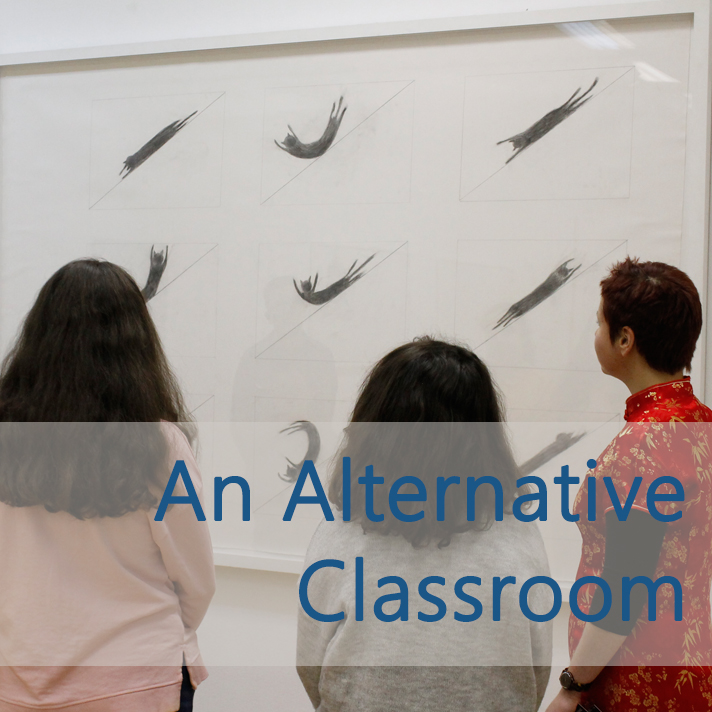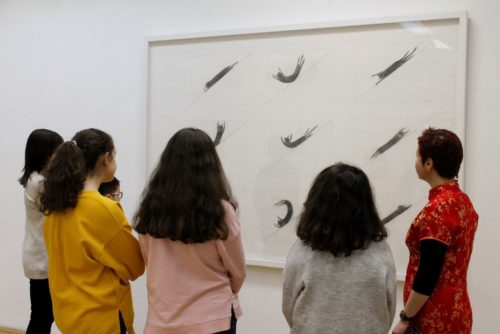
Micropop – an example of the education work with children at the National Gallery of Bosnia and Herzegovina
At the beginning of 2018, the audience of the National Gallery of Bosnia and Herzegovina had the opportunity to visit the exhibition “Winter Garden: The exploration of the Micropop Imagination in Contemporary Japanese Art”. A series of educational workshops for children was held as a part of the exhibition.
Written by: Aida Šarac
The goal of the educational work with children within this exhibition was to develop a deep understanding and experience of art as a result of the encounter with an original artwork. Museum exhibition space, with its unique purpose, décor and feeling of rituality imposed subconsciously, creates a special surrounding for active learning and knowledge accumulation outside the walls of a classroom. The learning process in this type of the alternative classroom is experienced as a play, while it also liberates children from fear of the museum as an institution.
the encounter with an original artwork. Museum exhibition space, with its unique purpose, décor and feeling of rituality imposed subconsciously, creates a special surrounding for active learning and knowledge accumulation outside the walls of a classroom. The learning process in this type of the alternative classroom is experienced as a play, while it also liberates children from fear of the museum as an institution.
Primary goal of the educational programme in the National Gallery of Bosnia and Herzegovina is not just to introduce children with the values of art or to teach them various techniques and colours. Primary is to create grounds for visual literacy of the participants, develop the vocabulary and critical thought, which is possible through active learning with the help of various experiences enabled through the art and a specific feeling emitted by the spaces itself.
Every experience resulting from the encounter with an artwork, even repeated one, bears a different quality and cognition, given that the “here and now” in front of the artwork is irreplaceable. It is confirmed through the pedagogy that children learn best through the experience and its upgrading, and not through the simple transfer of information and facts stating.
In the introductory part of the programme in question, the insight into the basic knowledge about the country of origin of the artworks is gained through the conversation. The facts and conclusions made by the group are associated with the exhibits, e.g. the Japanese flag is associated with the installation “The Sun” (author Ryoko Aoki) and the fact that the Japan is island nation is associated with the drawing on tiles “Ocean of Answers” (author Masanori Handa) etc.
Although the education programme is multidisciplinary, elementary method used are Visual Thinking Strategies (VTS). VTS is an approach to experiencing art through careful, close looking and questioning. VTS empowers students to discuss art based on what they can see in an artwork.
VTS is based on a discussion, the workshop facilitator asks participants a set of questions while they are looking at an image, encouraging them to express their subjective opinions about what they see. After each answer, facilitator paraphrases the given statement along with an affirmation and stimulates further discussion.
This process is active, because the children individually explore the exhibition and all its contents. By asking questions and inviting children to a direct dialogue, facilitator gives the children opportunity to individually conclude what they see. This way, the artwork is approached from different angles and perspectives, e.g. analysing the relationship between the parts and the whole, perceiving the shapes on the wall surface and specificities of the installation as a medium, and, in the end, discussing the content of an artwork.
Active learning in an exhibition space as an alternative classroom is also done through the group work. The participants have the opportunity to for individual exploration, critical thinking and exchange of ideas within the group. The result of the group work in this case were the labels for the artworks with the description of a given exhibit.
Educational programme is completed with creative and manual work of the participants, under the influence of the visual sensations experienced during the exhibition visit.
Learn more about the exhibition
